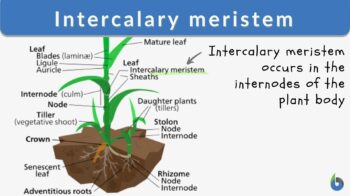
Intercalary meristem
n., plural: intercalary meristems
[in′tər·kə‚ler·ē ′mer·ə‚stem]
Definition: (botany) A type of meristematic tissue at the base of nodes and leaf blades of monocots
Table of Contents
The basic structural framework of plants is composed of different types of tissues. Based upon the capacity to divide, the plant tissues can be classified into two main types namely permanent tissues and meristematic tissues. In contrast to permanent tissues, the cells of meristematic tissues don’t lose their capacity to divide. They don’t differentiate to gain a permanent shape, size, or function; rather, they remain relatively small, immature, and cytoplasmically dense with high respiration rates.
On the basis of origin, meristematic tissues are of two types namely primary and secondary meristems. the primary meristematic tissues are derived directly from the meristems of embryos whereas the secondary meristematic tissues are derived from the permanent tissues by the process of dedifferentiation. Among the primary meristematic tissue, there are three types based on the position of the tissue. They are:
1) Apical
2) Intercalary
3) Lateral
If asked in plants, where does growth occur? We can explain that it occurs at apices (both root and shoot apices) with the help of “Apical Meristem”. It occurs in the internodes of the plant body with the help of the “Intercalary Meristem”. And it occurs along with the girth of the plant body with the help of “Lateral Meristem”. Let’s look at the diagram below to help define and distinguish intercalary meristem.
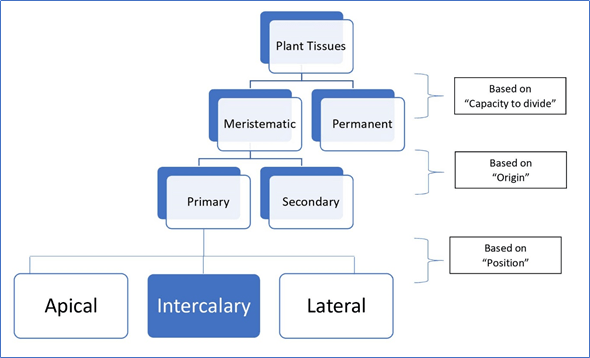
Intercalary Meristem Definition
An intercalary meristem is a primary meristematic tissue that helps a plant or tree to grow vertically by adding to its length. The cells in this meristematic region are small, totipotent, thin-walled, and full of protoplasm. The distinctive features of intercalary meristem are as follows:
- dividing in nature
- primary (originating directly from an embryo) by origin
- intercalary (between permanent tissues) by position
Since the intercalary meristem is mitotically (dividing) active, it adds in vertical growth or intercalary growth of the plant, thereby giving its name.
Unlike the other primary meristematic tissues, the intercalary meristem eventually has limits; it will eventually reach a limit and mature into permanent tissues.
Some scientific literature also points out the intercalary meristem is actually inserted meristematic tissue in the mature tissue. Apical meristem has been pointed as the source of intercalary meristem in such theory. After insertion, the apical tissue is said to be separated by successively formed nodes into a number of intercalary sections, which ultimately form a number of intercalary meristems. (Krishnamurthy K.V. et al., 2015, Xiong W.Y, 1980 and Schweingruber F.H., 2018)
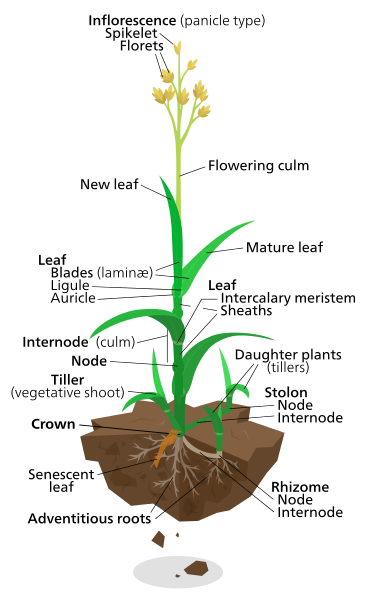
Intercalary meristem is a type of meristematic tissue, such as that found at the base of nodes and leaf blades of monocots. Intercalary meristem is a type of meristematic tissue associated with the growth in length in the middle position, thus the name. In particular, it is made up of meristematic cells that divide mitotically in the stem at the base of nodes and leaf blades. The growth at this point is referred to as intercalary growth. This is essential to these plant groups as it serves as an adaptive mechanism against herbivory. Through intercalary growth, these plants are able to rapidly regrow leaves and elongate stems to compensate for plant parts grazed by herbivores.
Synonym: intercalary meristematic tissue; intercalary growth tissue.
Two Possible Sources of Intercalary Meristems
Intercalary meristem can arise from two sources, which are far behind the shoot and root tips. One is subapical meristem, which lies at the base of apical meristem and contributes “directly” to the formation of the intercalary meristem. Another is by the process of dedifferentiation of mature tissues, which “indirectly” leads to the formation of intercalary meristem in the latter part of the life of the plant.
- Subapical meristem
This happens by gradual restriction of division activity to any region of the internode/floral axis/spike axis where it is very much prolonged contributing significantly to internodal tissues. - Dedifferentiation of mature tissues
Intercalary meristem often matures into developed tissues but some part of it remains “silently preserved” even after maturation. When some environmental, growth or developmental condition triggers this quiescent tissue, it goes into dedifferentiation. Dedifferentiation of mature tissues is the transformation of cells from a given highly differentiated state to a less differentiated or stem cell-like state). By this pathway, contributes to the division activity for a very long time and is usually the major contributor to the longitudinal growth in the latter part of plant life.
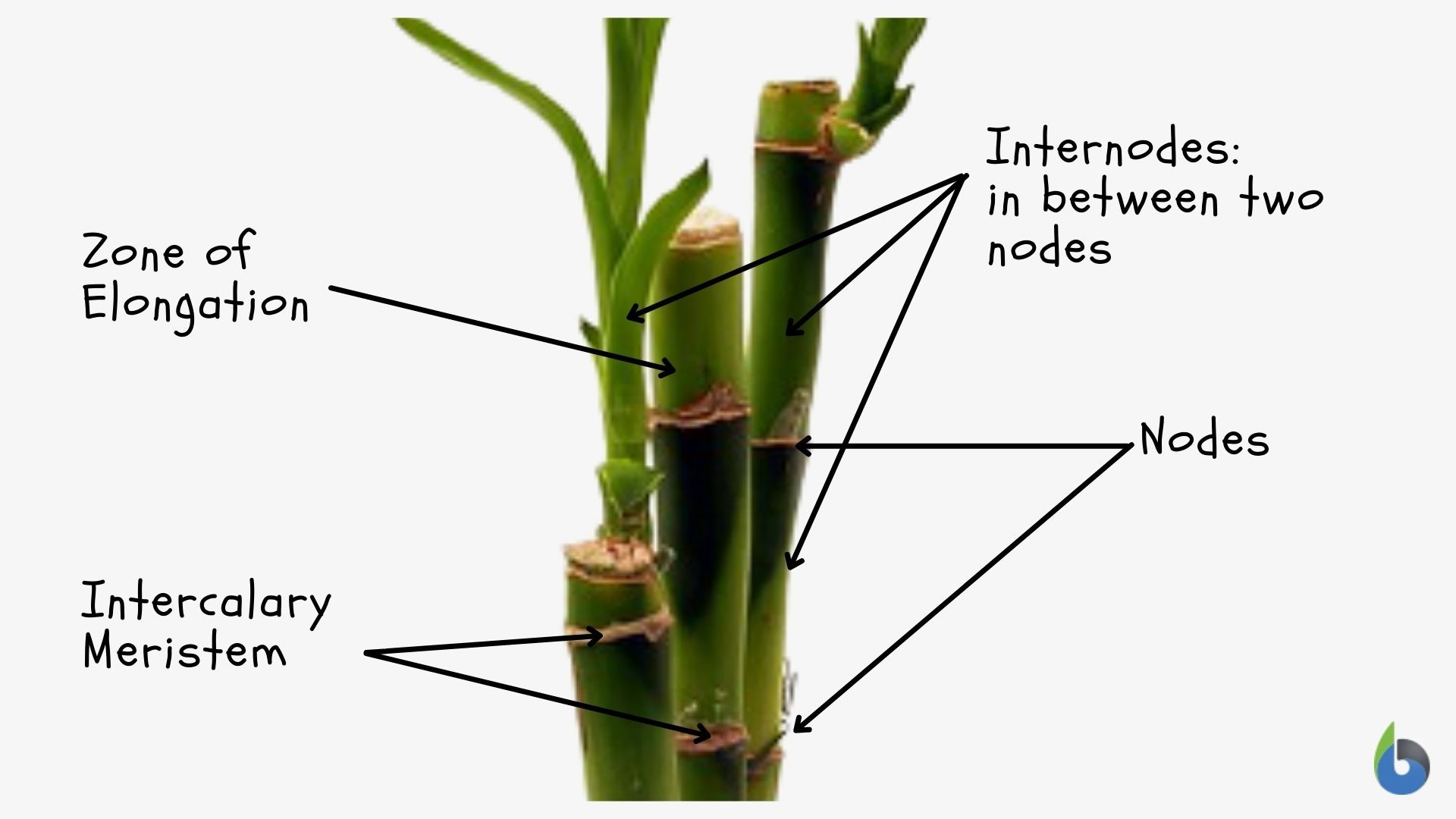
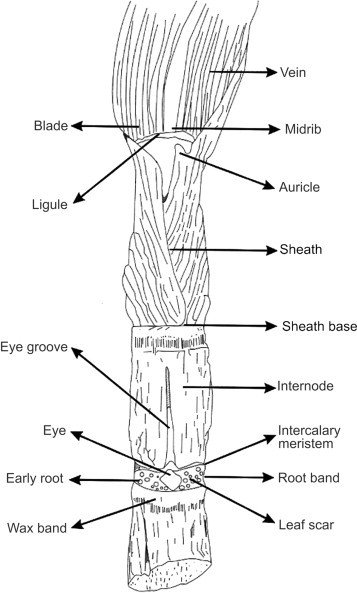
Presence in Different Plant Lineages
Different plant lineages starting from thallophytes (algae), bryophytes (mosses), pteridophytes (ferns) to gymnosperms (conifers, cycads) and angiosperms (monocots and dicots) have shown innumerable occurrences of intercalary meristems.
Although the position of the intercalary meristems and their functions vary a lot along with the entire spectra, the significance in general plant growth and development remains the same.
Angiosperms
Among angiosperms, the intercalary meristem is commonly found in monocots. Although both monocots and dicots have a shoot apical meristem, it divides during development to form an additional meristem below the apex i.e. intercalary meristem only in monocots and not in dicots. This process is continuous until the onset of flowering and creates the intercalary meristems located in the nodes of grasses.
Exceptions:
- Intercalary meristem has been noticed in mint (Mentha arvensis) which is a member of Lamiaceae and in peanut plants (Arachis hypogea), which is a member of Fabaceae. (Both Lamiaceae and Fabaceae are dicotyledonous angiosperm families.)
- Intercalary meristem has also been noticed in some dicotyledonous vines. Example: Ipomoea spp., Thunbergia grandiflora.
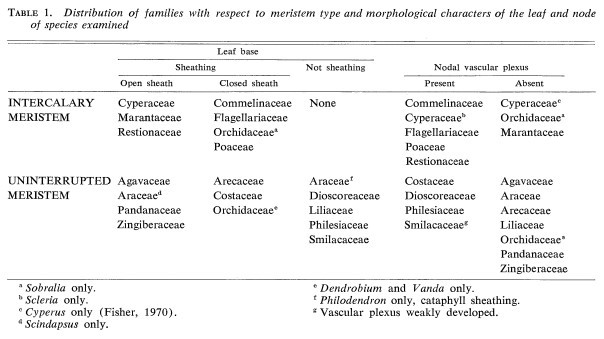
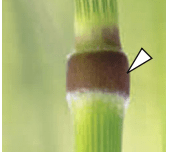
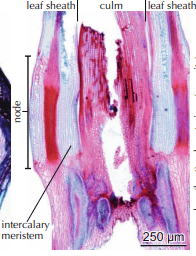
Elongation zone with the unlignified meristematic cells in Poaceae leaf sheath.
Source: Schweingruber F.H., 2018
Gymnosperms
Among gymnosperms, intercalary meristem has been observed in Pinus. In Pinus cataphyll (reduced leaves of gymnosperms) development, intercalary meristem plays a crucial role.
Thallophytes
Among thallophytes/algae, intercalary meristems have been reported in the lamina of kelps (Phaeophyta/Brown algae). Intercalary meristem in kelps is present between stipe and blade to increase the length of the thallus.
Pteridophytes
Among pteridophytes/ferns, intercalary meristem has been observed in horsetails (Equisetum spp.). Aerial shoots of Equisetum spp. have intercalary meristems but no data is available regarding their presence in rhizomes.
How intercalary meristem helps in vegetative growth of Equisetum spp. shoot?
The sequence of events that lead to the formation of intercalary meristem in Equisetum spp. is explained below. Once the intercalary meristem is formed in Equisetum spp., it aids in the vegetative growth in conjunction with the apical meristem.
- Apical cells in the vegetative shoot divide and lead to the formation of “merophytes”.
- These merophytes work in synchrony and lead to the development of units called “phytomers”.
- A phytomer can be further partitioned into two distinct tiers
- an upper nodal tier
- a basal internodal tier
- It is this basal internodal tier that retains the meristematic activity and leads to the formation of intercalary meristem of Equisetum spp.

Functions of Intercalary Meristems
Just like in animals, an organ or tissue can serve varied multiple roles in different lineages, genera and species; similarly, in plants, intercalary meristematic tissue plays along different lines of action. Ranging from vertical (longitudinal) growth to grazing tolerance to gynophore formation, it serves some impeccable requirements of a plant to survive and multiply. Some of the most important roles of intercalary meristem are listed below:
1) It helps fallen stems of cereal plants to become erect.
2) It helps in the regeneration of lawn grass removed by grazing herbivores or repeated mowing.
3) It helps in the height growth of bamboo, by the elongation of internodes.
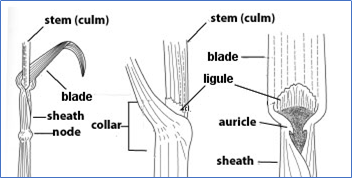
4) It plays a huge role in the developmental morphology and physiology of grasses. When grasses grow, at first, the entire leaf primordium has meristematic activity but eventually, the cellular division gets restricted to intercalary meristem. When ligule formation (figure 8) is happening, intercalary meristematic activity ceases within the blade. When the ligule is exposed, intercalary meristematic activity ceases within the sheath. Hence the basal location of the intercalary meristematic tissue within the 2 major parts of grasses- blade and sheath explains why leaf elongation can occur following defoliation/grazing/repeated mowing without replacement of the leaf tip.
If we compare the meristematic activity of different meristems in grasses, we essentially gather two major points:
- The growth rate of replacement grass leaves is fastest by intercalary meristem and slowest by axillary meristem. Hence, intercalary meristem in grasses is often referred to as grass meristem.
Intercalary Meristem > Apical Meristem > Axillary Meristem
Figure 9: Comparison of the meristematic activity of different meristems of plants: intercalary, apical, and axillary bud meristem. Source Briske D.D., 1986 - Axillary buds confer perenniality to the plant while intercalary meristems are short-lived.
5) In culmed grasses like sorghum, millet, and sugarcane, intercalary meristem plays a pivotal role in culm elongation. In the malt preparation of these grasses, culm forms an important part of the malt product. The more elongated the culm, the more the quantity yield of malt is extractable. Additionally, due to their high nutritional value, they are used as wholesome animal feeds.
6) In peanuts (Arachis hypogea), the gynophore formation happens in proximity to the ovary due to the presence of intercalary meristem in the ovarian stalk. This intercalary meristem gets activated only after pollination and successful fertilization. The role of intercalary meristem here is to bury the fertilized ovary deep into the soil.
7) In kelps (Phaeophyta/Brown algae), intercalary meristem helps in increasing the length of the thallus.
Intercalary Meristem Examples
In summary, intercalary meristems are exemplified by the following autotrophs and their location:
- Present in members of Poaceae, i.e. grasses and cereals (at base of internodes and above the nodes)
- Present in mint (below the nodes)
- Present in Pinus (at the base of the leaves)
- Present in bamboo (in internodes)
- Present in sugarcane (at the base of the several uppermost internodes)
- Present in Equisetum (located above each node)
- Present in Arachis hypogea (in ovarian stalk)
- Present in kelps, Chorda filum (in both vegetative and sporophytic phases)
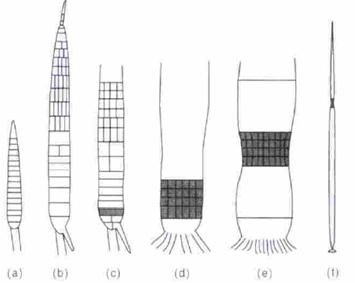
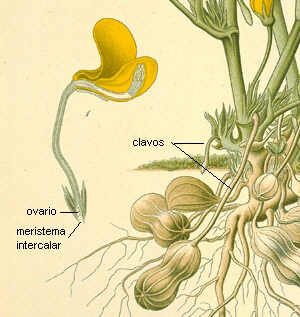
Fun Fact about Intercalary Meristem
No, it’s the sound of the sudden growth of corn culm due to the rapid elongation of the intercalary meristem. Since the elongation occurs in a very spontaneous manner in corn, you can hear it growing… (Source: Losos J.B., 2010).
Try to answer the quiz below to check what you have learned so far about intercalary meristem.
Further Reading
References
- Xiong W.Y., Ding Z.F., Li Y.F. (1980). Intercalary meristem and internodal elongation of bamboo plants. Scientia Silvae Sinicae, 16: 81-89.
- Briske D.D., (1986) Chapter 4- Developmental Morphology and Physiology of Grasses
- Animal Feed Resources Information System, “Malt culms, malt sprouts, malt coombs”
- Knoller A.S., Blakeslee J.J., Richards E.L., Peer W.A., Murphy A.S. (2010). Brachytic2/ZmABCB1 functions in IAA export from intercalary meristems. Journal of Experimental Botany, 61(13): 3689–3696.
- French J.C., Fisher J.B. (1977). A Comparison of Meristems and Unequal Growth of Internodes in Viny Monocotyledons and Dicotyledons. American Journal of Botany, 64(1): 24-32
- Jiang F., Feng Z., Liu H., Zhu J. (2015). Involvement of Plant Stem Cells or Stem Cell-Like Cells in Dedifferentiation. Frontiers in Plant Science, 6(1028)
- Sacher J.A. (1955) Cataphyll Ontogeny in Pinus lambertiana. American Journal of Botany, 42(1): 82-91
- French J.C. (1984). Occurrence of Intercalary and Uninterrupted Meristems in Equisetum. American Journal of Botany, 71(8): 1099-1103
- Tomescu A.M., Escapa I.H., Rothwell G.W., Elgorriaga A., Cúneo N.R. (2017) Developmental programmes in the evolution of Equisetum reproductive morphology: a hierarchical modularity hypothesis. Annals of Botany, 119(4):489-505
- Fisher J.B., French J.C. (1976). The Occurrence of Intercalary and Uninterrupted Meristems in the Internodes of Tropical Monocotyledons. American Journal of Botany, 63(5): 510-525
- Jacobs W.P. (1947) The development of the gynophore of the peanut plant, Arachis hypogaea -the distribution of mitoses, the region of greatest elongation, and the maintenance of vascular continuity in the intercalary meristem. American Journal of Botany, 32: 361-370
- Kogame Y., Kawai H. (1996) Development of the intercalary meristem in Chorda filum (Laminariales, Phaeophyceae) and other primitive Laminariales. Phycological Research 44(4):247 – 260
- Bizzo W.A., Lenço P.C., Carvalho D.J., Veiga J.P.S. (2014) The generation of residual biomass during the production of bio-ethanol from sugarcane, its characterization and its use in energy production. Renewable and Sustainable Energy Reviews, 29: 589–603
- Krishnamurthy K.V., Bahadur B., Adams S.J., Venkatasubramanian P. (2015) Meristems and Their Role in Primary and Secondary Organization of the Plant Body. Plant Biology and Biotechnology, 1(4): 113-151
- Schweingruber F.H., Börner A. (2018) The Plant Stem. Chapter 6: 43-79 https://doi.org/10.1007/978-3-319-73524-5_6
- Losos J.B., Mason K.A., Singer S.R. (2010) Biology. Edition Eighth, Pg 720.
©BiologyOnline.com. Content provided and moderated by Biology Online Editors.




